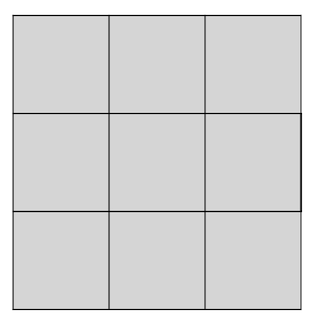How we figure it out: How many squares you can find in a 3x3 grid
A peek into how we learn extremely deviates from how we are taught
This is the first post in the series How children figure it out.

When I was in the 5th grade in a cornered town in Gujarat, we were beginning to learn English as the 3rd language.
Achieving good grades in English was both easy and rewarding: Easy because all one had to do was perfectly memorize “I am”, “You are”, and “He is” couplets, and apply them to fill in the blanks. Rewarding because English was the language of our past rulers, and those who could just talk in English got an unprecedented career advantage over other clever people: Technology experts, Science evangelists, and good teachers.
Times have changed; English is more regarded because it is an international language. But those were the 80s. India wasn’t even an open economy then; globalization was still 3 years away.
How many squares you can find in a 3x3 grid?
I can’t forget the only incident that occupied my entire memory of the 5th grade.
Three white (probably British) ladies visited our school (whom I would later assume to be educational NGO members or pedagogy researchers). They arrived sometimes around an hour before the end of the school day. Students from 5th-7th grades were invited into the hall, only to attend what was a highly unique occurrence: A school visit by a foreigner.
The ladies seemed to be in their 40s. They looked quite friendly. They wore forever charming smiles on their faces. They sat right behind a blackboard, something out of place in what was our regular prayer hall.
The teacher in charge of welcoming the ladies pacified the eager-to-go-home students. Then, as she gestured towards them, the ladies rose and stepped forward.
One of them turned to the blackboard and drew a 3x3 squares grid.
She said out loud her question in English, which our teacher translated to:
How many squares do you see in this image?
There was a 5-second silence in the hall. A murmur ensued, and everyone around me was talking about the obvious answer: 9. It was a no-brainer, after all. I could hear some students laughing looking at the white lady - how she underestimated them!
When I heard everyone around me was betting on 9, I felt a bit motivated. Because I was already pondering the answer: 10. No one was looking at the entire shape!
That didn’t last long. Within 30 seconds, I heard “Ten!” from a distant corner of the hall. I couldn’t spot the source of the answer. But it wasn’t from any of the top scorers of all grades present - something I strongly correlated with intellect at that time.
The audience lost interest. The murmuring increased. The teacher stood up to pacify the crowd. The ladies wore anxious smiles, wondering if their puzzle was too boring for the young teenagers of India.
Looking at their unease, I had a spark. Two thoughts occurred to me simultaneously (notice the italicized parts, they would come back later):
It can’t be too easy. I didn’t know why I thought that. If I had to think through it today, I would have a rational take: These white ladies didn’t travel this far, only to see if 5th-7th graders of India can count squares in plain sight. But no such thinking could happen at that time.
I had seen this before. Probably in a puzzle magazine, my father brought home in the last vacation. It was a 4x4 grid. I had tried, but couldn’t work it out myself. Then I saw the answer and somehow remembered how it was arrived at.
I instantly rose and went to the blackboard. Facing the writer lady, I announced: The answer is 14. Her faint smile instantly turned into an awestruck grin. The other two smiled at me as well, but one of them wanted me to show it. She gestured towards the blackboard.
I took her cue and picked up the chalk. Using overlapping lines, I showed her 4 more squares besides the ten already announced.
There was a brief silence in the hall. The puzzler lady announced: “It is the correct answer!”
Most of the audience understood her statement but were waiting for a confirmation. When the teacher, with a proud smile, began to clap, the school understood: We had cracked it.
Amid the thunderous applause, I missed several heartbeats.
All 3 ladies shook hands with me. I don’t remember their faces. But I still recollect the range of emotions their eyes revealed: Awe, surprise, a glint of hope, shared joy of an accomplishment.
The teacher patted my back in appreciation, and I went back to my place.
I don’t remember anything else from that day, except narrating it all to my family, including my grandparents. The narrative was enriched with a lot of laughter because I mimicked the foreign ladies’ English accent - a mark of my English prowess blended with a heavy dose of comic moments our school lived.
As I would realize later in my life, this incident served less as proof of my early talent and more as a confidence reinforcement milestone - something that helped me persist every time I was lost in a thousand-step puzzle.
In the next part of the How Children Figure Things Out series, I will reveal the insights I had from this singular incident. Over several years, I was able to extract them from the recurring memory of it.



